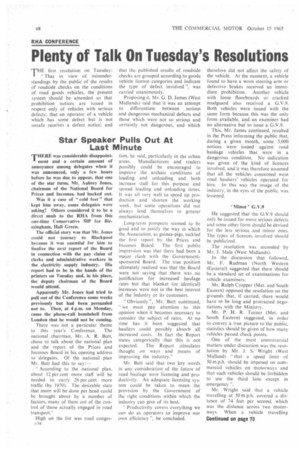Plenty of Talk On Tuesday's Resolutions
Page 70

If you've noticed an error in this article please click here to report it so we can fix it.
THE first resolution on Tuesday: That in view of misunderstandings by the public of the results of roadside checks on the conditions of road goods vehicles, the present system should be amended so that prohibition notices are issued in respect only of vehicles with serious defects; that an operator of a vehicle which has some defect but is not unsafe receives a defect notice; and
that the published results of roadside checks are grouped according to goods vehicle licence categories and indicate the type of defect involved ", was carried unanimously.
Proposing it, Mr. G. D. James (West Midlands) said that it was an attempt to differentiate between serious and dangerous mechanical defects and those which were not so serious and certainly not dangerous, and which
therefore did not affect the safety of the vehicle. At the moment, a vehicle found to have a worn steering arm or defective brakes received an immediate prohibition. Another vehicle with loose floorboards or cracked mudguard also received a G.V.9. Both vehicles were issued with the same form because this was the only form available, and an examiner had no alternative but to issue a G.V.9.
This, Mr. James continued, resulted in the Press informing the public that, during a given month, some 5,000 notices were issued against road haulage vehicles that were in a dangerous condition. No indication was given of the kind of licences involved, and it was therefore assumed that all the vehicles concerned were road hauliers' vehicles operated for hire, In this way the image of the industry, in the eyes of the public, was lessened.
Minor' G.V.9 He suggested that the G.V.9 should only be issued for more serious defects and some other form should be devised for the less serious and minor ones. The types of licences involved should be publicized.
The resolution was seconded by Mr. J. Male (West Midlands).
In the discussion that followed, Mr. F. Rudman (North Western (Eastern)) suggested that there should be a standard set of examinations for vehicle examiners.
Mr. Ralph Cropper (Met. and South Eastern) opposed the resolution on the grounds that, if carried, there would have to be long and protracted negotiations with the Ministry.
Mr. P. H. R. Turner (Met. and South Eastern) suggested, in order to convey a true picture to the public, statistics should be given of how many vehicles passed check points.
One of the most controversial matters under discussion was the resolution by Mr. J. S. Wright (West Midland) "that a speed limit of 50 m.p.h. should be imposed on commercial vehicles on motorways and that such vehicles should be forbidden to use the third lane except in emergency ".
Mr. Wright said that a vehicle travelling at 50 m.p.h. covered a distance of 74 feet per second, which was the distance across two motorways. When a vehicle travelling Continued on page 73








































































































































